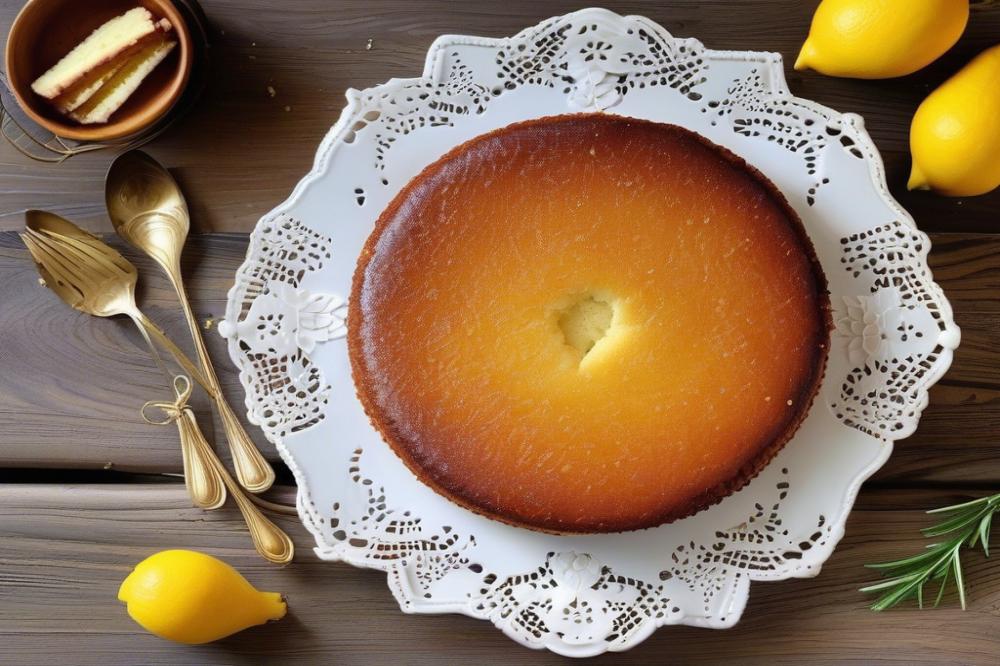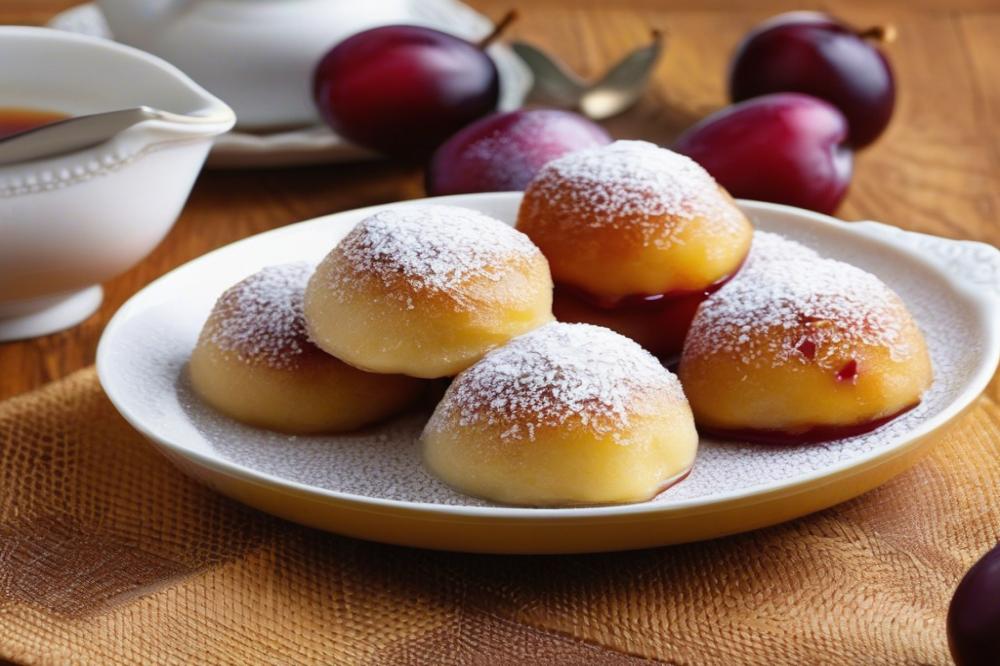Classic Greek Revani Semolina Cake
Revani is a delightful dessert known throughout Greece. This dish showcases the simplicity and flavor of Greek cuisine. Loved by many, it features a base of semolina, often enhanced with flavors like orange zest and coconut. Each bite offers a fluffy cake that is not only satisfying but also comforting.
The importance of this cake goes beyond just being a treat. It often appears during celebrations and family gatherings. Revani represents tradition, comfort, and the joy of sharing food with loved ones. Preparing this easy recipe can bring a touch of Greek culture into your home. The process of baking it connects families to their heritage, creating lasting memories.
Syrup plays a crucial role in this dish, soaking into the cake and adding moisture. This combination makes every bite a sweet experience. By embracing these flavors, you will discover the heart of Greek baking. Making a Greek semolina cake is a fantastic way to explore this rich culinary tradition.
If you’re looking for a dessert that blends simplicity with flavor, this cake is the perfect choice. Its unique taste will surely impress anyone who takes a bite. Plus, it’s an excellent way to enjoy the art of traditional baking. Start your journey with Revani, and transform your understanding of Greek desserts.
Revani: The Heart of Greek Desserts

Historical Background of Revani
Revani is a beloved dessert steeped in history. Originating in the Ottoman Empire, it found a home in Greek kitchens. Made with semolina, this fluffy cake has become a staple of Greek cuisine. Over centuries, families passed down the tradition of baking this sweet treat. Its preparation involves simple ingredients, yet the result is extraordinary. Historically, it was often reserved for special occasions, making it a cherished dish among generations.
Cultural Significance in Greek Gatherings
When Greeks come together, food takes center stage. Revani holds a special place at many celebrations, such as weddings and holidays. Serving this dessert is a way to share joy and hospitality. A plate of revani can bring warmth to any gathering. The sweet syrup, often infused with orange zest, elevates it to a new level of delight. Including coconut in the recipe adds a twist that enhances its flavor. Guests feel welcomed and cherished when this cake is present.
Comparison to Other Desserts
Many desserts grace Greek tables, yet few rival the charm of revani. Unlike baklava, which is rich in nuts and layers, revani is simpler but equally delicious. Greeks also enjoy galaktoboureko, a custard-filled pastry wrapped in phyllo. That dish is more complex and time-consuming. Although they differ in texture and taste, each dessert carries its own sweetness. An easy recipe for revani can be a warm, inviting treat, perfect for any occasion. With its combination of flavors, this semolina cake stands out as a timeless choice.
Ingredients for Revani Semolina Cake

This classic Greek dessert is made from simple ingredients that come together to create a delightful treat. Below are the ingredients you’ll need, along with their measurements:
- 1 cup semolina – This grain offers a unique texture, giving the cake a rich and hearty quality.
- 1 cup all-purpose flour – Combining with semolina, it helps create a fluffy structure.
- 1 cup sugar – Adds sweetness, elevating the cake’s flavor to the next level.
- 4 eggs – These are crucial for binding everything together and adding moisture.
- 1 cup yogurt – This ingredient introduces a tangy flavor and contributes to the cake’s tenderness.
- 1/2 cup vegetable oil – Oil keeps the cake moist and enhances its richness.
- 1 cup milk – Provides extra moisture, making the cake even fluffier.
- 2 tsp baking powder – This leavening agent helps the cake rise perfectly during baking.
- Zest of 1 orange – Orange zest adds a refreshing citrus note that brightens the entire dessert.
- 1/2 cup desiccated coconut (optional) – Coconut can introduce an extra layer of flavor and texture if desired.
Nutritional information can be useful when baking. Let’s explore the benefits of these ingredients:
- Semolina: Rich in protein, it contributes to muscle and tissue repair.
- All-purpose flour: High in carbohydrates, it provides essential energy.
- Sugar: While it offers quick energy, moderation is key.
- Eggs: These are packed with protein and essential vitamins like B12.
- Yogurt: It’s a source of probiotics, supporting gut health.
- Vegetable oil: This contributes healthy fats, important for brain function.
- Milk: A source of calcium, it supports strong bones and teeth.
- Baking powder: Contains minimal calories but essential for rising.
- Orange zest: Offers antioxidants and a burst of flavor.
- Desiccated coconut: Provides healthy fats and fiber, adding texture.
This easy recipe showcases the delicious blend of flavors in Greek cuisine. Incorporate these ingredients to achieve a delightful semolina cake that is sure to impress!
Step-by-Step Cooking Instructions

Preparation of Ingredients
Begin by gathering all your ingredients. You will need semolina, flour, eggs, sugar, baking powder, yogurt, and oil. Don’t forget the zest of an orange and shredded coconut for flavor. Measure everything precisely. Having all ingredients ready will make the process smoother and more enjoyable.
Mixing Dry and Wet Ingredients
In a large bowl, combine the dry ingredients. This includes semolina, flour, sugar, and baking powder. Stir them together well. In another bowl, mix the wet ingredients. Combine yogurt, eggs, oil, and orange zest. Blend these until they are smooth. Slowly add the wet mix to the dry ingredients. Stir gently until everything is incorporated. You want a uniform batter, but don’t overmix it. The goal is to achieve a light, fluffy cake.
Baking the Cake
Preheat your oven to 350°F (175°C). Grease a baking dish to prevent sticking. Pour the batter evenly into the dish. Smooth the top with a spatula. Place it in the oven and bake for about 30 to 35 minutes. The cake should turn golden brown. A toothpick test can help; if it comes out clean, your cake is ready!
Making the Syrup
While the cake is baking, prepare the syrup. In a saucepan, combine water and sugar. To enhance the flavor, add a pinch of orange zest. Bring the mixture to a boil and let it simmer for about 10 minutes. This will create a sweet syrup that complements your dessert perfectly.
Pouring Syrup Over the Cake
Once the cake is out of the oven, allow it to cool for a few minutes. Carefully pour the hot syrup over the warm cake. Make sure to cover the surface evenly. The syrup will soak in, adding sweetness and moisture. This step is crucial for achieving the classic flavor that defines traditional Greek desserts.
Allowing the Cake to Absorb Syrup
Let the cake sit for at least an hour after pouring the syrup. This waiting period allows the cake to absorb all that delicious syrup. As it sits, the semolina creates a nice texture. Enjoy the anticipation as the flavors meld together. Afterward, slice and serve. You can garnish with additional coconut if desired. This easy recipe is sure to impress anyone who loves Greek cuisine.
Tips for Baking the Perfect Revani

Choosing the Right Semolina
Selecting semolina is an important step in making this classic dessert. Fine semolina works best for creating that fluffy texture you want. Coarse semolina can make your cake dense and grainy. Look for high-quality, durum wheat semolina. The right choice can enhance flavor, and thereby, the overall experience.
Baking Time and Temperature Adjustments
Baking time can vary based on your oven. It’s wise to start checking the cake a few minutes early. A toothpick inserted in the center should come out clean. If your cake browns too quickly, lower the temperature slightly. Remember, every oven has its quirks, so adjust accordingly for best results.
Storing Leftovers
You might find yourself with leftovers after enjoying this delightful treat. Store the remaining pieces in an airtight container to keep them fresh. Room temperature works great for a few days. For longer storage, consider the fridge. Just allow the cake to cool completely before sealing it.
Serving Suggestions
This delicious semolina cake pairs beautifully with a dollop of whipped cream or a scoop of vanilla ice cream. Drizzling some warm syrup on top adds richness. Consider adding a sprinkle of freshly grated coconut or a hint of orange zest for extra flair. Each addition enhances the traditional flavor, making the cake even more enjoyable.
Variations of Revani
Regional Variations Across Greece
Throughout Greece, you will find diverse takes on the traditional semolina cake. Each region adds its own twist, creating a delicious variety. In Crete, for example, bakers often incorporate almonds or walnuts, lending a rich texture. On the other hand, in the Peloponnese, you might discover a revani soaked in a sweeter syrup, making it even more delightful. These variations showcase the creativity in Greek cuisine. Different regions have unique flavors, so exploring them can be a tasty journey.
Gluten-Free Alternatives
For those who cannot eat gluten, don’t worry! There are easy recipe adjustments available. Almond flour is a popular substitute for semolina in this fluffy cake. Coconut flour can also be used to create a light and airy texture. Both gluten-free options maintain the spirit of the dessert while satisfying those with dietary restrictions. This means anyone can enjoy the sweet delight of revani without missing out.
Flavoring Options with Different Citrus or Nuts
Experimenting with flavors can elevate your baking experience. Adding orange zest enhances the cake’s aroma and taste significantly. You might also try lemon for a zesty kick or even grapefruit for something more unusual. Mixing in crushed pistachios or hazelnuts adds an extra crunch to every bite. The possibilities are endless! Each variation offers an exciting twist on a classic dessert. Feel free to be adventurous when creating your own version.
Wrapping Up Your Baking Adventure
To summarize, the process of creating a classic Greek semolina cake is both rewarding and enjoyable. Begin by mixing simple ingredients like semolina, sugar, and yogurt. Combine them until smooth before baking. Once you achieve the golden crust, the sweet syrup poured over tops it off beautifully. Each step is essential to achieving that moist, flavorful dessert that will leave everyone wanting more.
We encourage you to give this recipe a try in your own kitchen. Making this delightful treat may seem challenging at first, but the result is absolutely worth the effort. Picture the smiles on your family’s faces as they savor each bite. Your friends will surely appreciate your baking skills while enjoying a slice of such a delicious cake.
Have you ever tried baking a semolina cake? If so, we invite you to share your experiences and any tips you may have. Everyone has their own stories to tell. Your insights could inspire others to start their baking journey as well. So, roll up your sleeves and get ready to create a delightful masterpiece!



